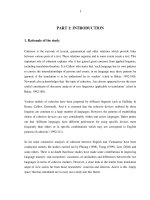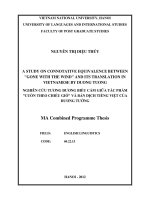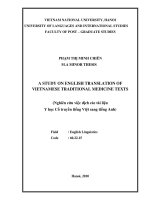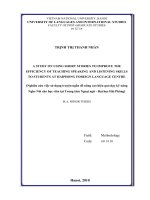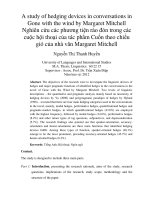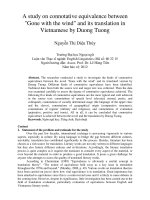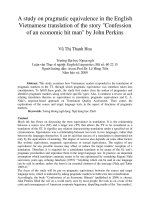a study on connotative equivalence between gone with the wind and its translation in vietnamese by duong tuong = nghiên cứu tương đương biểu cảm giữa tác phẩm cuốn theo chiều gió
Bạn đang xem bản rút gọn của tài liệu. Xem và tải ngay bản đầy đủ của tài liệu tại đây (818.44 KB, 77 trang )
VIETNAM NATIONAL UNIVERSITY, HANOI
UNIVERSITY OF LANGUAGES AND INTERNATIONAL STUDIES
FACULTY OF POST GRADUATE STUDIES
NGUYỄN THỊ DIỆU THÚY
A STUDY ON CONNOTATIVE EQUIVALENCE BETWEEN
"GONE WITH THE WIND" AND ITS TRANSLATION IN
VIETNAMESE BY DUONG TUONG
NGHIÊN CỨU TƯƠNG ĐƯƠNG BIỂU CẢM GIỮA TÁC PHẨM
"CUỐN THEO CHIỀU GIÓ" VÀ BẢN DỊCH TIẾNG VIỆT CỦA
DƯƠNG TƯỜNG
MA Combined Programme Thesis
FIELD: ENGLISH LINGUISTICS
CODE: 60.22.15
HANOI - 2012
VIETNAM NATIONAL UNIVERSITY, HANOI
UNIVERSITY OF LANGUAGES AND INTERNATIONAL STUDIES
FACULTY OF POST GRADUATE STUDIES
NGUYỄN THỊ DIỆU THÚY
A STUDY ON CONNOTATIVE EQUIVALENCE BETWEEN
"GONE WITH THE WIND" AND ITS TRANSLATION IN
VIETNAMESE BY DUONG TUONG
NGHIÊN CỨU TƯƠNG ĐƯƠNG BIỂU CẢM GIỮA TÁC PHẨM
"CUỐN THEO CHIỀU GIÓ" VÀ BẢN DỊCH TIẾNG VIỆT CỦA
DƯƠNG TƯỜNG
MA Combined Programme Thesis
FIELD: English Linguistics
CODE: 60.22.15
SUPERVISOR: Assoc. Prof. Dr. LÊ HÙNG TIẾN
HANOI - 2012
iv
TABLE OF CONTENTS
DECLARATION …………………………………………………… i
ACKNOWLEDGEMENT…………………………………………….ii
ABSTRACT……………………………………………………………iii
PART A: INTRODUCTION………………………………………… 1
I. Statement of the problem and rationale for the study…………………1
II. Research aims and research questions…………………………………2
III. Scope of the study…………………………………………………….3
IV. Methods of the study………………………………………………….3
PART B: DEVELOPMENT…………………………………………….5
CHAPTER 1: LITERATURE REVIEW………………………………5
1.1. Definition of translation……………………………………………….5
1.2. Translation equivalence……………………………………………….6
1.2.1. Jakobson and the concept of equivalence in difference………6
1.2.2. Nida and Taber's Formal dynamic equivalence………………7
1.2.3. Catford and translation shifts……………………………… 10
1.2.4. Kade and quantitative equivalence ………………………… 11
1.2.5. Baker's approach to translation equivalence………………….12
1.2.6. Koller's theory of equivalence……………………………… 13
1.3. Translation of literature ………………………………………………15
1.4. Translation methods………………………………………………… 17
1.5. Translation procedures……………………………………………….19
1.6. The author and the novel …………………………………………….22
v
1.6.1. The author Margaret Mitchell………………………………… 22
1.6.2. The novel "Gone with the wind"………………………………26
1.7. The translator and the translation…………………………………… 29
1.7.1. The translator Dương Tường………………………………… 29
1.7.2. The translation "Cuống theo chiều gió"……………………….30
CHAPTER 2: DEVELOPMENT……………………………………… 31
2.1. Connotations of socially determined usage……………………………31
2.1.1. The language of the upper class ………………………………31
2.1.2. The language of the slaves……………………………………. 35
2. 2. Connotations of speech level………………………………………… 41
2.2. 1. Elevated……………………………………………………….41
2.2.2. Colloquial…………………………………………………… 47
2.2.2. 1. Interjections………………………………………….48
2.2.2.2. Exclamations…………………………………………50
2.2.3. Poetic………………………………………………………… 54
2.3. Connotations of geographical origin or relation……………………… 58
2.4. Connotations of register……………………………………………… 62
2.4.1. Military usage…………………………………………………62
2.4.2. Religious usage……………………………………………….67
2.4.3. Normal usage………………………………………………….68
2.5. Connotations of evaluation……………………………………………72
2.5.1. Pejorative………………………………………………………73
2.5.2. Positive…………………………………………………………76
2.5.3. Ironic……………………………………………………………80
CHAPTER 3: FINDINGS AND RECOMMENDATIONS………………85
3.1. Summary of findings…………………………………………………… 85
vi
3.1.1. Types of connotative equivalence achieved…………………………85
3.1.2. Strategies adopted to achieve connotative equivalence…………… 86
3.2. Recommendations…………………………………………………………89
3.2.1. To achieve connotations of socially determined usage………………89
3.2.2. To achieve connotations of speech level…………………………….90
3.2.3. To achieve connotations of geographical origin………………… 90
3.2.4. To achieve connotations of register………………………………….90
3.2.5. To achieve connotations of evaluation………………………………91
PART C: CONCLUSION……………………………………………………92
I. Summary and conclusion of the study……………………………………….92
II. Contributions of the study………………………………………………… 92
III. Limitations of the study…………………………………………………….93
IV. Suggestions for further studies…………………………………………… 94
REFENRENCES……………………………………………………………….95
1
PART A: INTRODUCTION
I. Statement of the problem and rationale for the study
Over the past few decades, international exchange is processing vigorously
in various aspects, especially in culture. By using language to bridge the gap
between different cultures, inevitably, translation has contributed significantly to
this process. Besides, literature has been chosen as a rich source for translation.
Literary works are not only written in different languages but they also feature
different cultures and civilizations. Accordingly, the literary translation process is
quite complex as it requires the translator to consider every aspect of the material,
or even beyond the material in order to produce a good translation. It poses a great
challenge for anyone who attempts to assess the quality of translated literary
works.
According to Chesterman (1989) “Equivalence is obviously a central
concept in translation theory”. “The notion of equivalence held sway as a key issue
in translation throughout the 1970s and beyond.” (Munday, 2008, p. 49). Various
works on translation theories have been carried out just to show how vital
equivalence is in translation. Great importance has been attached to equivalence
since this is a controversial issue and it is likely to cause debates in the coming
time. However, despite its significance, little investigation has been carried out in
the field of translation evaluation, particularly evaluation of equivalence between
English and Vietnamese literary works.
All the above made the researcher decide to carry out the study on
equivalence in literary translation. Specifically, the study investigates connotation
equivalence achieved in the translation of “Gone with the wind” – one of the most
famous novels of the 20
th
century. This novel has been chosen as the source
2
language text due to its distinctive features, aesthetic values and popularity
worldwide. The novel was first translated into Vietnamese more than 20 years ago.
Among several versions of the translation, the one translated by Duong Tuong is
most praised by readers. With the aim of investigating one of Duong Tuong's best
translated works, the researcher chose his translation as the target text.
II. Research aims and research questions
The study firstly aims at providing a theoretical background on some issues
relevant to the topic of the study, which are translation, literary translation,
equivalence in translation and strategies to achieve equivalence.
Secondly, the study is to investigate the types of connotative equivalence
achieved between the novel and its translated version.
Thirdly, the study is also aimed at finding out what strategies adopted by the
translator in order to achieve that equivalence.
Addressing the above issues is hoped to help English learners, especially
those specialize in translation enhance their awareness of various expressive means
employed in a particular literary text and decide the most appropriate strategies to
deal with different translation situations.
The study is also expected to be a good reference of criteria to any
Vietnamese readers who love romantic novel, and are fans “Gone with the wind”
for a good translation.
These aims can be formulated into the following research questions.
1. What types of connotative equivalence achieved between the novel "Gone
with the wind" and its translation by Duong Tuong?
2. What strategies adopted by the translator to achieve such types of
connotative equivalence?
III. Scope of the study
3
Firstly, the theoretical background of the study only focuses on some
fundamental issues in translation theory which are of vital importance to the issue
examined, which are translation, equivalence, methods, and procedures.
Secondly, the research focuses on one kind of equivalence, which is
connotative equivalence. Then only the most outstanding types of connotative
equivalence are examined.
IV. Methods of the study
1. Data collection
The study is designed in accordance with the theory proposed by Koller
(1979), that is characterizes the connotative dimensions of a source language (with
the support of stylistic studies) to analyse their features and structural elements,
and then relate these to the connotative dimenstions of a given target language. In
the first stage, the study explores the source language text to find out the different
dimensions of connotations. The features and structural elements of each
connotative dimension are defined. Data are collected in both English and
Vietnamese to illustrate these dimensions. Even though the novel is almost six
hundred pages long, the researcher tries to collect comprehensive data by
investigating almost every chapter. Subsequently, the examples are grouped
according to the stated catergory for the sake of comparison and assessment.
2. Data analysis
In the second stage of the study, an assessment of the features in the target
language text is carried out with the criteria established in the first stage. The
translation and the data are considered from various viewpoints. The study is based
on technical data of semantic densities, occurrence probabilities and repetition
rates of both the source language and target language text to evaluate the degree of
4
connotative equivalence achieved. As stated by Koller (1979), equivalence is
defined in terms of the frame and conditions that the target text must fulfill if there
exists equivalence between a given source text and a given target text. The
conditions can be content, style, function, etc. Therefore, the requirement of
equivalence has the following form: quality (qualities) X in the source language
text must be preserved, meaning the source language content, form, style, function,
etc must be preserved or at least the translation must seek to preserve them as far
as possible (Koller, 1979). Besides, the connotations are transmitted by means of
the word choice. Thus, the word choices that can affect the content, form, style or
function of translation are investigated carefully. After that, conclusions on types
of connotative equivalence achieved are drawn. Furthermore, based on the
translation of Duong Tuong, the researcher also figures out the strategies employed
to achieve connotative equivalence. The strategies are categorized according to
Newmark's theory about translation methods and translation procedures.
5
PART B - DEVELOPMENT
CHAPTER 1 – LITERATURE REVIEW
1.1. Definition of translation
Translation, as one of the most ancient activity of human beings, has
intrigued numerous researchers all over the world. They all attempt to define
translation for the sake of research, and their definitions share one common thing:
the relationship between the source text and the target text.
In the “Dictionary of Translation Studies”, Shuttleworth and Cowie
acknowledge that translation is an “incredibly broad notion which can be
understood in many different ways”. And this idea is proved by numerous
definitions proposed by different researchers around the world.
As early as 1959, the structural linguist Roman Jakobson proposes a
tripartite definition of translation. The first type is intralingual translation or
rewording, which is an interpretation of verbal signs by means of other signs of the
same language. The second type is interlingual, or another name is translation
proper. It is an interpretation of verbal signs by means of some other language. The
third type is intersemiotic translation or transmutation, which is an interpretation of
verbal signs by means of signs of nonverbal sign systems.
Hatim and Munday (2004) take a different approach with the focus on “the ambit
of translation”, which is defined as 1) the process of transferring a written from SL
to TL, conducted by a translator, or translators, in a specific socio-cultural context;
2) the written product, or TT, which results from that process and which functions
in the socio-cultural context of the TL; and 3) the cognitive, linguistic, visual,
cultural and ideological phenomena which are an integral part of 1) and 2).
However, in Munday‟s viewpoint, such definitions like those of Roman Jakobson
6
or by he and Hatim do not address the limits on translation and other outstanding
issues in this field.
Nida and Taber (1982, p.12) claim that “Translation consists in reproducing
in the receptor language the closest natural equivalent of the source language
message, first in terms of meaning and secondly in terms of style”.
Catford (1965, p.20) defines translation as “the replacement of textual
material in one language (Source language) by equivalent textual material in
another language (target language)." This idea is shared by Hartmann and Stock
(1972, p713) with their definition “Translation is the replacement of a
representation of a text in one language by a representation of another equivalent
text in a second language.”
Interestingly, Dubois (as cited in Bell, 1991, p.5) expresses the same notion
“Translation is the expression in another language (or target language) of what has
been expressed in another (source language), preserving semantic and stylistic in
equivalences”.
1.2. Translation equivalence
As stated in the introduction, the concept of equivalence in translation is
highly controversial. Numerous theories have been devoted to the study of
equivalence. The thesis introduces the most distinguished theories and its
influence.
1.2.1. Roman Jakobson and the concept of equivalence in difference.
Roman Jakobson claims “equivalence in difference is the cardinal problem
of language and the pivotal concern of linguistics” and introduced the notion of
"equivalence in difference". On the basis of his semiotic approach to language, he
suggests three kinds of translation (1959, 232)
7
- Intralingual (within one language, i.e. rewording or paraphrase)
- Interlingual (between two languages)
- Intersemiotic (between sign systems)
In his point of view, “there is ordinarily no full equivalence between code-
units” because “the translator recodes and transmits the message from another
source. Thus translation involves two equivalent messages in two different codes”
(p.139). The problem of meaning and equivalence lies in the structure and
terminology of languages rather than the inability of one language to render a
message into another language. He acknowledges that "whenever there is
deficiency, terminology may be qualified and amplified by loanwords or loan-
translations, neologisms or semantic shifts, and finally, by circumlocutions" (p.
234). Jakobson's theory requires the translator has to recode the source text
message first and then s/he has to transmit it into an equivalent message for the
target readers.
1.2.2. Nida and Taber's Formal equivalence and dynamic equivalence
Nida quotes Belloc (1931) “There are, properly speaking, no such things as
identical equivalents”, and affirms that “One must in translating seek to find the
closest possible equivalent” (Nida, 1964, 159). Nida categorizes equivalence into
two fundamental types: formal equivalence and dynamic equivalence.
“Formal equivalence focuses attention on the message itself, in both form
and content….One is concerned that the message in the receptor language should
match as closely as possible the different elements in the source language.”
(Nida, 1964, 159)
Apparently, formal equivalence focuses on the source text structure, whose
role is to determine the accuracy of the translation. Formal equivalence is used to
get closer to the language and customs of the source culture.
8
The second type of equivalence proposed by Nida is dynamic equivalence
(or functional equivalence), in which “the relationship between receptor and
message should be substantially the same as that which existed between the
original receptors and the message” (Nida, 1964, p.159). In Nida‟s viewpoint,
“naturalness” is a central requirement, and the goal of dynamic equivalence is to
seek “the closet natural equivalent to the source language message” (Nida, 1964,
p.166; Nida & Taber, 1982, p.12). To satisfy this requirement, the message has to
be adapted to the linguistic needs and cultural expectations of the reader.
Formal equivalence focuses on style, meanwhile dynamic equivalence
emphasizes on meaning. The difference in focus of attention between these two
kinds of equivalence may pose difficulty for the translator as which type should be
prioritized when conflict arises. The fundamental rule drawn up by Nida is
“correspondence in meaning must have priority over correspondence in style” if
equivalence is to be achieved.
Nida‟s theory of translation is significant in introducing a reader-based
orientation to translation theory. However, it is also a controversial theory.
Munday does summarize some of the comments on Nida‟s work in the book. For
instance, Van den Broeck (1978, p.40) and Larose (1989, p.78) claim that it is
impossible to achieve equivalent effect. Edwin Gentzler (2001) criticizes Nida‟s
work for it intentionally converts the readers to the dominant discourse and ideas
of Protestant Christianity. Nonetheless, Nida‟s theory is without a doubt a
remarkable step in the development of Translation Studies, and exerts great
influence on many subsequent translation scholars, among them are Peter
Newmark and Werner Koller.
Five years later, Nida and his colleague Taber published another book on
translation called “The theory and practice of translation”, which Nida calls “the
9
logical outgrowth of the previous book “Toward a science of translation”. In the
introduction, Nida claims that previously, translating only focused on the form of
the message, meaning that translator only searched for “formal equivalence” -
Nida‟s term. However, the new focus in the response of the receptor or the reader,
meaning that translator should look for what Nida calls “dynamic equivalence”.
“Dynamic equivalence” was discussed in Nida‟s work in 1964, and was further
discussed in this book. The impacts of dynamic equivalence on the translation of
grammatical meaning, referential meaning and connotative meaning are studied.
Furthermore, the effect on translation of idioms, discourse structure, language
variety, types of discourse and style are also the topic of discussion.
Nida‟s theory is proved to be a controversial one and receives quite a lot of
disagreements and criticisms from other scholars. The French theorist Henri
Meschonnic (1987, p.77) argues that Nida‟s dynamic equivalence makes
translation become adaptation. Catford accused Nida of cultural imperialism (1969,
134). The Chinese scholar Qian Hu voiced the fiercest criticism Nida‟s concept is
wrong because “Total compatibility between any two languages is precluded”. He
explained that even two speakers of the same language do not understand the same
utterance the same way, let alone people speaking different languages. That sounds
reasonable and even Nida admitted that “Of course no communication, even within
a single language, is ever absolute (for no two people ever understand words in
exactly the same manner), and we certainly cannot expect a perfect match between
languages” (1969, 4-5).
Despite criticism against Nida‟s equivalence theory, Fawcett affirms that
“the book should be compulsory reading for all translators” (Translation and
Language. Linguistic theories explained, 58).
1.2.3. Catford and translation shifts
10
Catford considers equivalence a central term and says that “the central
problem of translation practice is that of finding target language translation
equivalents” while “a central problem of translation theory is that of defining the
nature and conditions of translation equivalence” (1965, p.21). He approaches the
issue of textual equivalence through translation “shifts”, meaning "departures from
formal correspondence in the process of going from the source language to the
target language" (p.73). He categorizes shifts into four types, which are structure
shifts, class shifts, unit shifts and intra – system shifts. In his viewpoint, two
utterances can be equivalent but they do not have the same meaning as different
languages will verbalize different situational features. Equivalence can be achieved
when the source and target words are “interchangeable in a given situation” and
this happens when “a source language and a target language text or item are
relatable (at least some of) the same features of substance” (Catford, 1965, 50).
Catford‟s theory may sound strange because his translation theory is closely related
to his linguistic theory. He also acknowledges that his theory of textual
equivalence has flaws and is the target of some criticism from other scholars.
However, his theory is no doubt valuable in the history of finding equivalence.
Catford was very much criticized for his linguistic theory of translation. One
of the most scathing criticisms came from Snell-Hornby (1988), who argued that
Catford's definition of textual equivalence is 'circular', his theory's reliance on
bilingual informants 'hopelessly inadequate', and his example sentences 'isolated
and even absurdly simplistic' (p. 19-20). She considers the concept of equivalence
in translation as being an illusion. She asserts that the translation process cannot
simply be reduced to a linguistic exercise, as claimed by Catford for instance, since
there are also other factors, such as textual, cultural and situational aspects, which
should be taken into consideration when translating. In other words, she does not
11
believe that linguistics is the only discipline which enables people to carry out a
translation, since translating involves different cultures and different situations at
the same time and they do not always match from one language to another.
1.2.4. Kade and quantitative equivalence
Otto Kade (as quoted in Pym, 2010) develops a theory that categorizes
equivalence at word or phrase- level into four modes:
“One – to- one”: one source language item corresponds to one target language
item. Most of the examples can be found in technical terms.
“One- to – several” or “several-to-one”: an item in one language corresponds to
several in the other language.
“One- to- part”: only partial equivalents are available, resulting in “approximate
equivalence”.
“One – to- none”: no full equivalence is available in the target language.
Kade‟s quantitative approach has been criticized because it is restricted to
the word level and it assumes that the language system can be equated with
concrete realization in text (Snell – Hornby, 1988, 20).
1.2.5. Baker's approach to translation equivalence
Baker (1992) explores the notion of equivalence at different levels, in
relation to the translation process, including all different aspects of translation
putting together the linguistic and the communicative approach.
The first level is equivalence at word- level and above word- level. Baker
acknowledges that, in a bottom-up approach to translation, equivalence at word
level is the first element to be taken into consideration by the translator. When the
translator starts analyzing the source text s/he looks at the words as single units in
order to find a direct 'equivalent' term in the target language. It is vital to notice
12
that a single word can sometimes be assigned different meanings in different
languages. This means that the translator should pay attention to a number of
factors when considering a single word, such as number, gender and tense (p.11-
12).
The second level is grammatical equivalence, referring to the diversity of
grammatical categories across languages. Grammatical rules may vary across
languages and this may pose some problems in terms of finding a direct
correspondence in the target language. Baker claims that different grammatical
structures in the source language and target language may cause remarkable
changes in the way the information or message is carried across. These changes
may induce the translator either to add or to omit information in the target text
because of the lack of particular grammatical devices in the target language itself.
Amongst these grammatical devices which might cause problems in translation
Baker focuses on number, tense and aspects, voice, person and gender.
The third level is textual equivalence, which refers to the equivalence
between a source language text and a target language text in terms of information
and cohesion. Texture is a very important feature in translation since it provides
useful guidelines for the comprehension and analysis of the source text which can
help the translator in his or her attempt to produce a cohesive and coherent text for
the TC audience in a specific context. The translation has to decide whether or not
to maintain the cohesive ties as well as the coherence of the SL text, based on three
main factors, that is, the target audience, the purpose of the translation and the text
type.
The final level is pragmatic equivalence, referring to implicatures and
strategies of avoidance during the translation process. Implicature is not about
13
what is explicitly said but what is implied. Therefore, the translator needs to work
out implied meanings in translation in order to get the source text message across.
The role of the translator is to recreate the author's intention in another culture in
such a way that enables the target reader to understand it clearly.
1.2.6. Koller's theory of equivalence
The thesis's focus is the theory of equivalence proposed by Koller. According to
Koller (1979), equivalence refers to the relationship between source language text
and target language text, rather than between two languages. When mentioning the
concept of equivalence, it is necessary to define the frame and conditions. Then, if
the target text fulfill certain conditions as defined, there exists equivalence between
a given source text and a given target text. Koller claims that the relevant
conditions refer to such aspects as content, style, function, etc. thus, the
requirement of equivalence has the following form: quality (qualities) X in the
source language text must be preserved, or at least the translation must seek to
preserve them as far as possible.
After defining the conditions of equivalence, Koller categorizes equivalence
into five types. The first type is denotative equivalence, which is “related to
equivalence of extralinguistic content of a text”. This kind of equivalence focuses
on the lexicon, meaning the words and syntagma of a language. From Koller's
point of view, denotative equivalence is in principle attainable.
The second types of equivalence and also the focus of the study is
connotative equivalence, which is related to the lexical choices, especially between
near – synonyms. Koller categorizes the following connotative dimenstions
relevant for translation:
14
(a) Connotations of speech level (connotative values such as elevated,
poetic, normal, colloquial, slang, vulgar)
(b) Connotations of socially determined usage (student language, military
usage, working –class language, educated class, etc)
(c) Connotations of geographical relation or origin (non-regional, American
English, dialects, etc)
(d) Connotations of medium (spoken language, written language)
(e) Connotations of stylistic effect (archaic, pompous, artificial, fashionable,
euphemistic, plain, descriptive, etc)
(f) Connotations of frequency (common, uncommon)
(g) Connotations of register (normal usage, technical, medical)
(h) Connotations of evaluation (positively evaluative, pejorative, ironic, etc)
(i) Connotations of emotion (emotive, neutral)
Koller states that the achievement of connotative equivalence is one of the
hardest tasks of the translator. Therefore, it is important to focus on particular
lexical and syntactic areas that are connotatively "loaded". The translator needs to
characterize the connotative dimensions of individual languages to analyse the
features and structures, then relate these to the connotative dimensions of a given
target language. Problematic cases in translations of particular texts can be
examined, and translation procedures involved in the area of connotation may be
identified.
The third type is text – normative equivalence, which is related to text – type
specific features.
The fourth type is pragmatic equivalence, which is oriented towards the
receiver of the text or message. The achievement of pragmatic equivalence means
that the text is translated to reach the intended receiver.
15
The last type is formal equivalence, which is related to the form and
aesthetics of the text, including wordplays and stylistic features of the source text.
To achieve formal equivalence, the translation must exploit the formal possibilities
of the target language text or even create new forms if necessary
It is impossible to achieve all these equivalences in one translation. Hence,
the translator must set up a hierarchy of values to be preserved in translation, or in
other words, the translator must order the equivalences hierarchically according to
the communicative situations.
1.3. Translation of literature
According to Tokarz, B (quoted in Fast, P. & Osadnik, W.M), “a literary
translation is a product of translatorial process, comprised of those linguistic texts
which serve the aesthetic ends in the communication process. They emotively
influence the receptor by their mode of expression, engaging his/her imagination,
intellect and sensitivity. A literary translation is characterized by its
intersubjectivity and the level of extra – and intratextual communication, as well as
its intertextuality and repicability in the ontological perspective with regard to its
form of existence within the universe of texts.”
Legezynska (1986, p. 11- 44) claims that because the translator being a
receptor of the original and the second author of the translation at the same time, in
a translation, the image of the original‟s author is parallel to the one of the
translator.
Landers as a translation theorist and translator himself states the requirement
for a literary translator “In addition to a thorough mastery of the source language,
the literary translator must possess a profound knowledge of the target language. In
reality, being in love with one or both languages, if not an absolute necessity, is a
16
trait frequently found among the best and most successful literary translators”
(2001, 7).
Lander states that the “majority view among translators has been that a
translation should affect its readers in the same way that the original affected its
first readers” (2001, 27).
Stockwell (2002, a), Venuti (1996), Pilkington (2000), Berman (1985/2000)
all mention the typical features of literary translation, and collected by Baker,
including: they have a written – based form, they enjoy canonicity (high social
prestige), they fulfill and effective/aesthetic rather than transactional or
informational function, they aim to evoke emotions and/or entertain rather than
influence or inform; they have no real- world truth- value (meaning they are judged
as fictional, whether fact-based or not); they feature words, images with ambiguous
and/or indeterminable meanings; they are characterized by “poetic” language use.
Conventional “core literary” genres are drama, poetry, and fictional prose.
However, a text only display some of the features listed above.
According to Baker, the focus of literary translation studies is source- target
text relations. Specifically, equivalence and communicative purpose are the main
focus of attention. Holmes (1988, 53) & Jones (1989) claim that the pivotal issue
regarding equivalence is the translator‟s ability to convey exactly the stylistic
features of literary texts. In case that situation is impossible, what should be given
priority? Another school of thought is that the translator should attach importance
to communicative effectiveness instead of equivalence. In terms of communicative
purpose, the question posed here is to what extent should the translator be loyal to
the original text?
17
According to Parks (1998/2007) & Boase – Beier (2006a), another concern is
translation of literary text is style. The writer‟s “cultural space – time” as well as
his/her intention and attitude are conveyed through the style of the text.
1.4. Translation methods
According to Newmark (1988), the central problem of translating has always
been whether to translate literally or freely. He proposes eight methods, ranging
from source text oriented methods to target text oriented ones.
1.4.1. Word-for-word translation
The typical feature of this method is that the source language word-order is
preserved and words are translated singly by their most common meanings, out of
context. Cultural words are translated literally. Word-for-word translation method
is used mainly to understand the mechanics of the source language or construe a
difficult text as a pre - translation process.
1.4.2. Literal translation
In this kind of translation method, the source language grammatical
constructions are converted to their nearest equivalents but the words are still
translated singly, out of context. This method is used as a pre – translation process.
1.4.3. Faithful translation
Faithful translation aims at reproduce the precise contextual meaning of the
original within the constraints of the target language grammatical structures.
Cultural words are transferred and grammatical and lexical "abnormality" are
preserved in the translation.
1.4.4. Semantic translation
18
This method attaches great importance to the aesthetic value (the beautiful
and natural sounds of the source language text, compromising on meaning where
appropriate). Less important cultural words may be translated by culturally neutral
third or functional terms but not by cultural equivalents. Semantic translation
offers great flexibility and creation.
1.4.5. Communicative translation
Communicative translation attemps to render the exact contextual meaning
of the original so that both the content and language are readily acceptable and
comprehensible to the target readers.
1.4.6. Idiomatic translation
This kind of translation method reproduces the message of the original but
tends to prefer colloquialism and idioms where these do not exist in the original.
1.4.7. Free translation
Free translation reproduces the matter without the manner, or the content
without the form of the original. This method often produces much longer
paraphrase than the original, resulting in prolix and pretentious translation.
1.4.8. Adaptation
This is the "freest" form of translation. This method is mainly used for plays, in
which the themes, characters and plots are usually preserved; the source language
culture is converted to the target language culture and the text is rewritten.
1.5. Translation procedures
Translation methods relate to whole texts, while translation procedures are
used for sentences and the smaller units of language. Newmark introduces various
procedures that can be employed by translators.
19
1.5.1. Literal translation
Newmark (1988) claims that literal translation is the most important and
basic procedure. Literal translation ranges from one word to one word through
group to group, collocation to collocation, clause to clause, to sentence to sentence.
1.5.2. Transference
Transference is the process of transferring a source language word to a target
language text as a translation procedure. The word then becomes a "loan word".
Proper names are often transferred.
1.5.3. Naturalization
This procedure adapts the source language word first to the normal
pronunciation, then to the normal morphology of the target language.
1.5.4. Cultural equivalent
In this procedure, a source language cultural word is translated by a target
language cultural word. The translation uses are quite limited as they are not
accurate but approximate cultural equivalents. However, cultural equivalent can be
used in public texts, propaganda, publicity, as well as for brief explanation to
readers who are ignorant of the relevant source language culture.
1.5.5. Functional equivalent
This procedure requires the use of a culture – free word, sometimes with a
new specific term. It neutralizes or generalizes the source language word. This
procedure, which is applied to cultural words, is the most accurate way of
translating as it deculturalize a cultural word.
1.5.6. Descriptive equivalent
20
In this procedure, the meaning of the original word is explained by several
target language word.
1.5.7. Synonymy
This procedure is used for a source language word where there is no clear
one – to – one equivalent, and the word is not important in the text, in particular for
adjectives or adverbs of quality. A synonym is only appropriate where literal
translation is not possible,
1.5.8. Through translation
Through translation is the literal translation of common collocations, names
of organizations. Normally, this procedure should be used only when they are
already recognized terms.
1.5.9. Shifts or transpositions
This procedure involves a change in the grammar from source language to
target language. This procedure may be used when a source language grammatical
structure does not exist in the target language, or when literal translation is
grammatically possible but may not accord with natural usage in the target
language. Another kind of transpositions is the replacement of a virtual lexical gap
by a grammatical structure. Transposition is the only procedure concerned with
grammar.
1.5.10. Modulation
Modulation is defined as a variation through a change of viewpoint, of
perspective, and of catergory of thought. There are several types of modulation,
such as "positive for double negative", "part for the whole", "abstract for concrete",
"cause for effect", "one part for another", "active for passive", "reversal of terms",
"change of symbols".
